Books
Books

Nasleep
Nasleep neemt de protesten rondom het Gezi Park in 2013 als vertrekpunt en verkent gaandeweg wat er is overgebleven van dit historische moment waarin een andere wereld voor het grijpen leek. Het zijn gedichten die laveren tussen ritmische, conceptuele en kritische noise enerzijds en postrevolutionaire affecten anderzijds, tussen politisering enerzijds en onmacht en radeloosheid anderzijds.

Vloekschrift
‘Arno Van Vlierberghe makes an impressive entrée into the poetry scene in the Low Countries with his first collection Vloekschrift, nominated for the C. Buddingh’-prize for the best debut volume of verse.’ (Patrick Peeters on Poetry International Web)
Arno Van Vlierberghe (1990) is dichter. Hij leeft, woont en werkt in Gent. Zijn werk verscheen her en der, offline en online. Vloekschrift is zijn debuutbundel.

Disparaitre #3
Third issue of Disparaitre, Ethan Assouline's publication. A long promenade in the city looking for new meanings in daily life, work, architecture(...) and new strategies for sabotage and autonomy using sex and poetry.
89 copies, riso printed.
Each back cover is unique and handmade.

How to Mend: Motherhood and Its Ghosts
In How to Mend: On Motherhood and its Ghosts, Kayfa ta’s 4th monograph, Iman Mersal navigates a long and winding road, from the only surviving picture of the author has with her mother, to a deep search through what memory, photography, dreams and writing, a search of what is lost between the mainstream and more personal representations of motherhood and its struggles. How to mend the gap between the representation and the real, the photograph and its subject, the self and the other, the mother and her child.
Iman Mersal is an Egyptian poet and associate professor of Arabic Literature and Middle Eastern Studies in the University of Alberta, Canada.
Text: Iman Mersal
Editors: Maha Maamoun and Ala Younis
Translated from Arabic by Robin Moger
Co-publishers: Kayfa ta and Sternberg Press
Design: Julie Peeters
Size: 9.6 x 14.8 cm
Pages: 168 pages, Soft cover

How to love a homeland
Russian writer and philosopher Oxana Timofeeva was born and grew up in various parts of the USSR. The book explores the difficulty of reducing one’s sense of homeland to one’s country alone, the philosophical interconnectedness of movement and rootedness, our plant and animal souls, and how we need to reimagine our desired, fictional if need be, homelands. The book interweaves vignettes from Timofeeva’s childhood across different parts of the USSR with a philosophical discussion of ideas on homeland in the thought of Brecht, Deleuze and Guattari, and other main figures of literature and philosophy.
Oxana Timofeeva is Sc.D., professor at “Stasis” Center for Philosophy at the European University at St. Petersburg, leading researcher at Tyumen State University, member of the artistic collective “Chto Delat” (“What is to be done”), deputy editor of the journal “Stasis”, and the author of books History of Animals (London: Bloomsbury Academic, 2018; Maastricht: Jan van Eyck, 2012), Introduction to the Erotic Philosophy of Georges Bataille (Moscow: New Literary Observer, 2009), Solar Politics(forthcoming, Polity, 2022).
Commissioned and published by Kayfa ta (2020)
Translation from Russian by Maria Afanasyeva
Design template by Julie Peeters
Cover illustration by Jumana Emil Abboud

How to remember your dreams
The book is a sharp and creative reflection on the interweaving of personal and national/ideological dreams. The chapters are on facts and fictions created in both, how one retraces one’s way through them, and through the numerous philosophers/thinkers/ideas (from Sartre to Zizek, Abdel-Nasser to Ibn Taymiya and others) that appear and shape his life journey, studies and dreams.
Amr Ezzat is an Egyptian writer who studied engineering and philosophy. He worked as an engineer and then a journalist before becoming a human rights researcher and a writer for numerous newspapers and other periodicals. He remembers his dreams very well.
Commissioned and published by Kayfa ta in 2019, printed in Beirut in 2021
Translated from English by Jennifer Peterson
Design template by Julie Peeters
Cover illustration by Hany Rashed

How to spell the fight
James R. Murphy, a math teacher in La Guardia, New York, regarded mathematics as the most powerful and manipulable abstract language available to humans. To acquaint students who don’t “like” math with abstract and systematical thinking, he put a piece of string in their hands and taught them to make string figures.
How to spell the fight follows a thread that has been running through our fingers from centuries past till the present day, morphing from the tangible string figures that join our hands in childhood to the more elusive computational algorithms that engage our fingers today. Following this line of inquiry through various twists and turns, a conversation about collective agency emerges with the aim of rethinking current paradigms of cognition, education, and power.
Natascha Sadr Haghighian is an artist living in Berlin. Her research-based practice encompasses a variety of forms and formats, among them video, performance, installations, text, and sound. She tries to learn how to make string figures.
Text: Natascha Sadr Haghighian
Commissioning editors: Maha Maamoun and Ala Younis
Copyeditor: Ryan Inouye
Co-publishers: Kayfa ta, Sternberg Press, and Tanmia Bookstores
Design template: Julie Peeters
Size: 9.6 x 14.8 cm
Pages: 80 pages, Soft cover
Printed in Cairo.

SSS – How to imitate the sound of the shore using two hands and a carpet
This publication takes up the issue of mimicking nature and demonstrates how to produce the sound of the sea using two hands and a synthetic carpet.
Artist book by Cevdet Erek
Translated by Ala Younis
Copyedited by Hanan Kassab and Maha Maamoun
Commissioning editors: Maha Maamoun and Ala Younis
Design: Julie Peeters
This publication is an adaptation of Cevdet Erek’s artist book SSS – Shore Scene Soundtrack, Theme and Variations for Carpet, originally published in Istanbul in 2007, by BAS (İstanbul Sanat Aras ̧tırmaları Dernegi), in the context of BENT, Artists’ Books from Turkey, edited by Banu Cennetoğlu and Philippine Hoegen, with design adviser Bülent Erkmen and prepress production assistant Oğuz Yaşargil.
These editions are produced in the context of and with support from Durub Al Tawaya (2014 and 2017); a program curated by Tarek Abou El Fetouh within Abu Dhabi Art.

How to disappear
This publication proposes a set of aural exercises that show readers how to disappear, reappear, join a group, or leave a group. Its annex is a lexicon of some of the sounds that dwell in or are banished from the middle-class household.
Text: Haytham El-Wardany
Editors: Maha Maamoun and Ala Younis
Translated from Arabic by Jennifer Peterson (Preliminary Exercises) and Robin Moger (Sounds of the Middle Classes)

Verlag der Buchhandlung Walther König
Amelie Von Wulffen: Works 1998-2016
A monograph on the German painter Amelie von Wulffen (born 1966).
For more than 20 years, the artist has been developing a formally and stylistically diverse oeuvre (including collages, installations, animated films, drawings, sculptures and paintings) that possesses a remarkable thematic consistency. Amelie von Wulffen: Works 1998-2016 shows the artist returning again and again to the process of coming to terms with the repercussions of German cultural history. These heavy themes are lightened by an acid humor, most obvious in Wulffen's drawings and comics, which spares no sacred cows. Richly illustrated with texts by Bernhart Schwenk and Amy Sillman, Amelie von Wulffen: Works 1998-2016presents the painter as a role model for a younger generation of artists.

Time Is A Mother
How else do we return to ourselves but to fold
The page so it points to the good part
In this deeply intimate second poetry collection, Ocean Vuong searches for life among the aftershocks of his mother's death, embodying the paradox of sitting within grief while being determined to survive beyond it. Shifting through memory, and in concert with the themes of his novel On Earth We're Briefly Gorgeous, Vuong contends with personal loss, the meaning of family, and the cost of being the product of an American war in America. At once vivid, brave, and propulsive, Vuong's poems circle fragmented lives to find both restoration as well as the epicenter of the break.
The author of the critically acclaimed poetry collection Night Sky With Exit Wounds, winner of the 2016 Whiting Award, the 2017 T. S. Eliot Prize, and a 2019 MacArthur fellow, Vuong writes directly to our humanity without losing sight of the current moment. These poems represent a more innovative and daring experimentation with language and form, illuminating how the themes we perennially live in and question are truly inexhaustible. Bold and prescient, and a testament to tenderness in the face of violence, Time Is a Mother is a return and a forging forth all at once.
![Cover of OEI #94-95 Geografier [Geographies]](https://rile.space/storage/1488/0216_Scan2022-04-15_140650_004.jpg)
OEI #94-95 Geografier [Geographies]
Jonas J. Magnusson, Cecilia Grönberg and 1 more
The new publication triangulates between geopoetics, geopolitics, and cultural geography; a 464 page issue with some 50 contributors as well as a large section on Swedish philosophical geographer Gunnar Olsson.
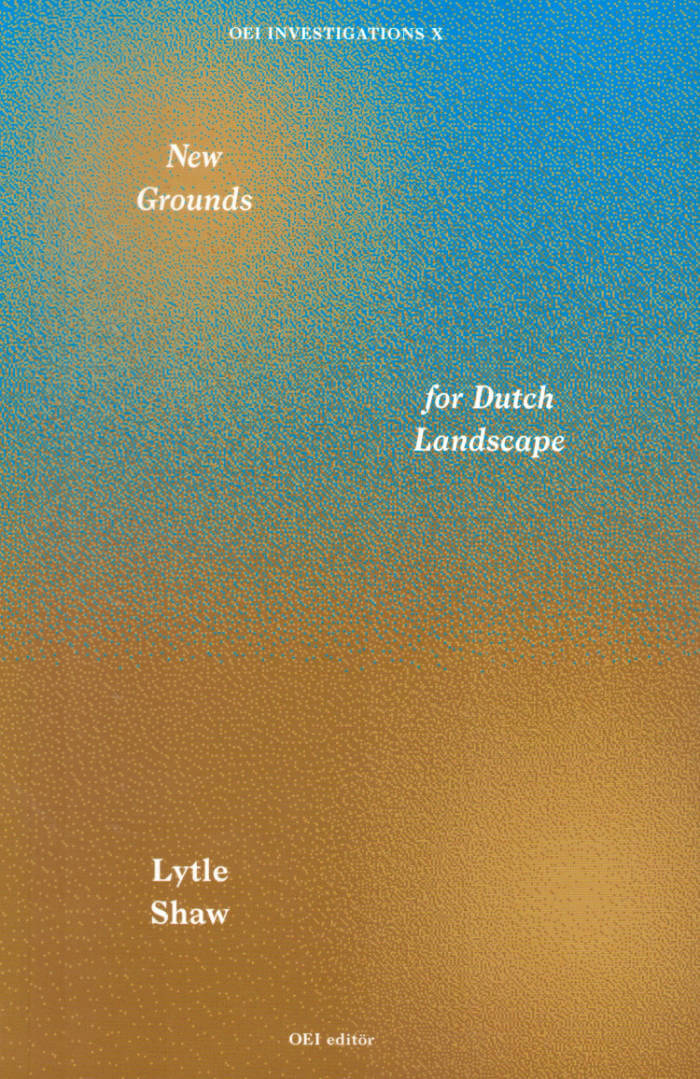
New Grounds for Dutch Landscape
New Grounds for Dutch Landscape uses an experimental, site-specific method to demonstrate how 17th century painters Jan van Goyen, Jacob van Ruisdael, and Meindert Hobbema did not so much represent the newly made landscape of Holland as reenact, through their painterly factures, its reclamation and ongoing threats to its stability: from flooding and drainage to abrasion and erosion.
These low-level dramas of recalcitrant matter allowed the Dutch to develop an ongoing temporality at odds with history painting’s decisive instant and a vocabulary of substance that wrested meaning away from humanist landscape painting’s expressive figures. — [publisher's note]
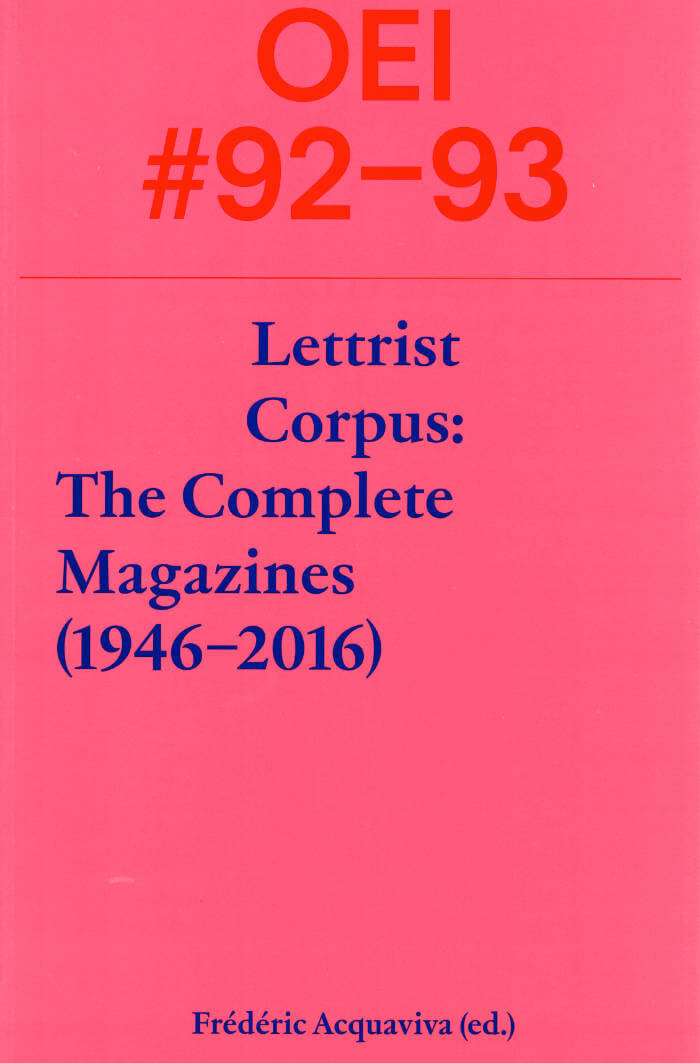
OEI #92-93 Lettrist Corpus: The Complete Magazines (1946–2016)
Frédéric Acquaviva, Jonas J. Magnusson and 1 more
“Un livre qui fera date. Deux ans de recherches, 512 pages, 1.361 illustrations en quadrichromie, 119 revues lettristes parues de 1946 à 2016 pour un total de 1.200 ouvrages décrits (avec la couverture et le sommaire de chaque numéro). Qui d’autre que les éditeurs suédois de OEI (Jonas J. Magnusson et Cecilia Gronberg) aurait pu sortir ce travail anthologique? Personne!” — www.mauricelemaitre.org
“The ‘unreasonable’ idea for this ‘catalogue raisonné’ came to me as an attemps to draw up a complete inventory of all the journals and periodicals of the Lettrist group, from its birth until today. Because the lifespan of the Lettrist movement has exceeded that of all the other avant-garde movements, we are undoubtedly in front of the most immense corpus ever produced in terms of magazines, coverin a period from 1946 to 2016. It presents more than a hundred different titles with more than one thousand items and hundreds of authors. . . . I hope that this comprehensive work will give the reader an opportunity to understand the different paths of the Lettrist groups and the many areas addressed, if not shaken, beyond the books of Isidore Isou and Maurice Lemaître. Since other Lettrists have published relatively few monographic books, and very little outside their own magazines, OEI #92-93 is a unique database for most of the Lettrist texts that we can access, also making it possible for new readers to come across Lettrism.”
— from Frédéric Acquaviva’s introduction
Design by Fält
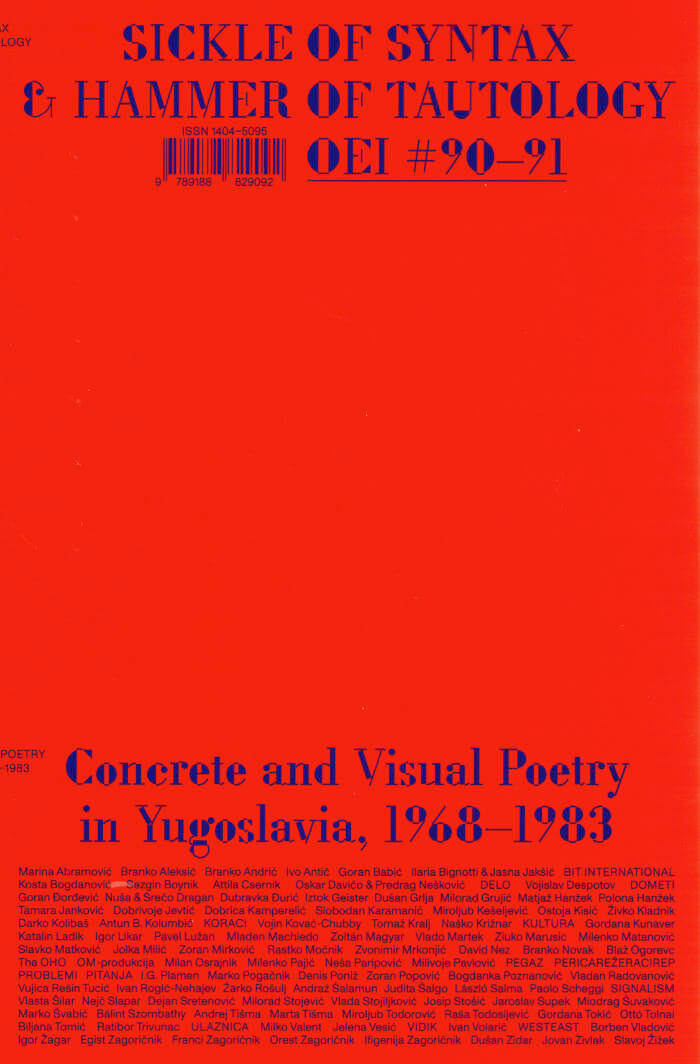
OEI #90/91 Sickle of Syntax & Hammer of Tautology
Tobi Maier, Cecilia Grönberg and 1 more
OEI # 90-91: Sickle of Syntax & Hammer of Tautology offers the first English language overview of the history of concrete and visual poetry production in socialist Yugoslavia between 1968 and 1983.
By focusing on mass-produced examples of concrete poetry, this publication presents these poetic experiments as organically linked to social movements, critical theories, and youth cultural revolutions. In his extensive introduction, Sezgin Boynik, the guest editor of this special issue of OEI, discusses concrete and visual poetry in socialist Yugo-slavia as an uneven and combined development, and emphasizes its confrontational and organizational aspects.
By means of interviews, translations, reproductions, and theoretical and historical statements, OEI # 90-91 offers a picture of a very lively scene of concrete and visual poetry in Yugoslavia, which unfortunately is not as recognized interna-tionally as it would deserve.
Hoping that OEI # 90-91 could contribute to this task in a substantial way, we present episodes from the early years of OHO formation and its complex theories of words and things; an interview with Rastko Močnik on programmed art and political formalism; militant polemics of Goran Babić; Signalist contradictions; subjective structural devices of Judita Šalgo; zaum experiments of Vojislav Despotov; detective meta-texts of Slavoj Žižek; poetic self-management studies of Vujica Rešin Tucić; a feminist historicisation of Ažin school for experimental poetry; democratisation of visual poetry by Westeast; selections from special issues of the journals Pitanja, Problemi, Ulaznica, Dometi, Delo, Koraci, Vidik, Pegaz, and many other materials translated here for the first time and presented in one publication.
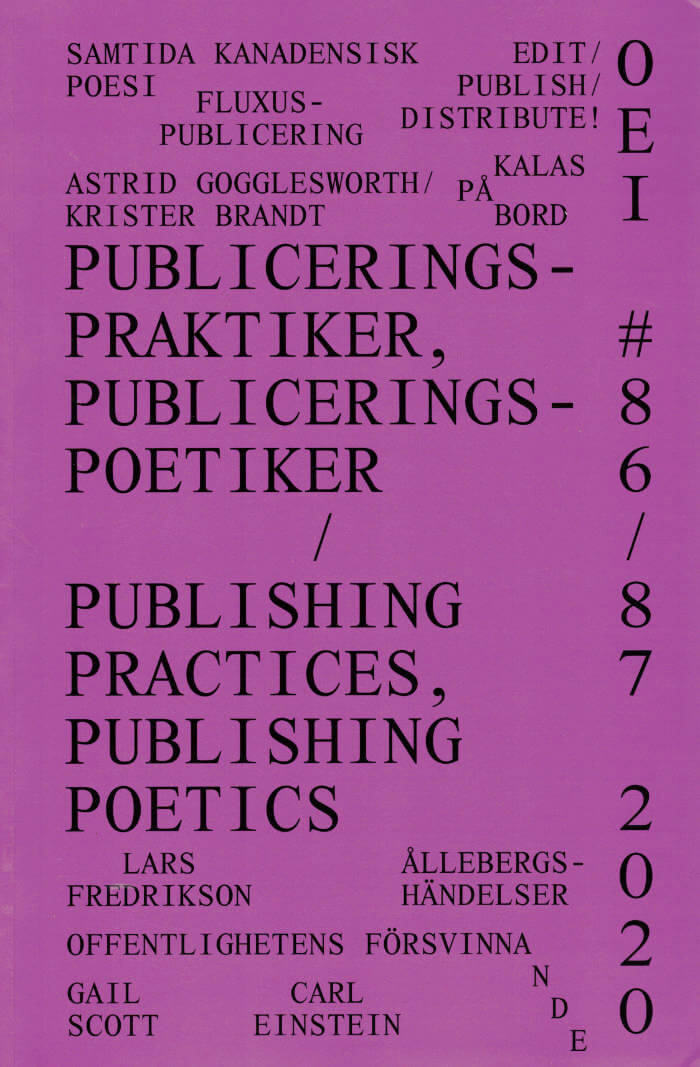
OEI #86/87 Publishing Practices, Publishing Poetics
Tobi Maier, Cecilia Grönberg and 1 more
Once more, an astonishing issue of OEI – a thrilling, compelling, stimulating feast of ideas regarding publishing and the book: the perfect big companion to read and hug in bed while the virus spreads outside.
Bringing together contributions from circa 130 publishing structures, publishing communities, magazines, small press endeavors, artists, poets, writers, editors, theoreticians, curators, scholars, and art bookstores, OEI # 86–87 reflects upon the challenges, pressures and possibilities of publishing and creating publics in different contexts and places in a time of far-reaching – economical, medial, political, social, technological – transformations.
The potential and the versatility of publishing open it to a diversity of practices and approaches in the arts, but as an eminently social form of art, a collective or micro-collective work with shared responsibilities, it is also a never-ending process of “crafting a variegated approach to how you create, publish, distribute, and build a social ecosystem around your efforts”, of trying to “build up and strengthen the community around these printed forms” (Temporary Services).
It is the conviction of OEI #86–87 that print has the power to play an important part in the construction of social spaces, of a social world. As Benjamin Thorel puts it in one of the essays in the issue, “conceiving of the dynamics of publishing as making publics as well as making things public is not a pun – insofar as the artists/publishers encompass, beyond the book itself, its possible ‘lives’, imagining the different spaces, and the different people, amongst whom a publication will circulate.” This is what Michael Warner has called “a public [as] poetic worldmaking”, implying “that all discourse or performance addressed to a public must characterize the world in which it attempts to circulate, projecting for that world a concrete and livable shape, and attempting to realize that world through address.”
This is also, as stressed by Annette Gilbert and others, what can make publishing such an active force, a force co-constituting texts and publications and publics. Indeed, with Michalis Pichler, it is tempting to say that in publishing as practice – perhaps more than in any other art field – “artists have been able to assert the aesthetic value of their own socio-politically informed concerns and to engage, often under precarious conditions, in cultural activities fully aligned with their political values.”
OEI #86–87 also includes sections on and with contemporary poetry from Canada; Fluxus publishing; Krister Brandt/Astrid Gogglesworth; Kalas på BORD (Öyvind Fahlström); Lars Fredrikson; Claude Royet-Journoud’s poetry magazines; Carl Einstein; Gail Scott; Ållebergshändelser; OEI #79: edit/publish/distribute!; “det offentligas försvinnande” and many many other things. [publisher’s note]
Design by Konst & Teknik

OEI #82-83 Art in the Age of Kleptomania
Jonas J. Magnusson, Cecilia Grönberg and 1 more
Aeron Bergman and Alejandra Salinas, co-editors at INCA Press (along with Irena Borić), are the guest-editors of this issue of OEI: it contains essays, artworks, and archival materials by 21 artists, theorists, writers, and artist-run spaces (mostly from the Americas).
The subject of the issue is art and neoliberalism, and it encompasses essays, images and other works by Dorothée Dupuis, Max Jorge Hindered Cruz, Luciano Concheiro, Yvonne Osei, Diego Bruno, John Riepenhoff, Suhail Malik, Good Weather, The Luminary, Bikini Wax, Beta-Local and more.

OEI #80/81 The Zero Alternative
Tobi Maier, Cecilia Grönberg and 1 more
OEI #80-81 is not an anthological publication, and has no representative ambition. It is a montage-based publication trying, in as material a way as possible, to register, prolong, transform and reflect upon energies from the work of Portuguese artist Ernesto de Sousa and his fellows (Alberto Carneiro, Túlia Saldanha, Álvaro Lapa, Fernando Calhau, Lourdes Castro, Ana Vieira, Ana Hatherly, E.M. de Melo e Castro, António Barros...).
Ernesto de Sousa and his fellows defined themselves as aesthetic operators and worked as filmmakers, photographers, curators, critics, writers, folk art researchers, multimedia artists... OEI #80-81 also gathers texts on magazines such as Poesia Experimental, Operação, Nova, A Urtiga, and Alternativa; and works by artists from younger generations such as Isabel Carvalho, Paulo Mendes and Mariana Silva, in dialogue with that of de Sousa.
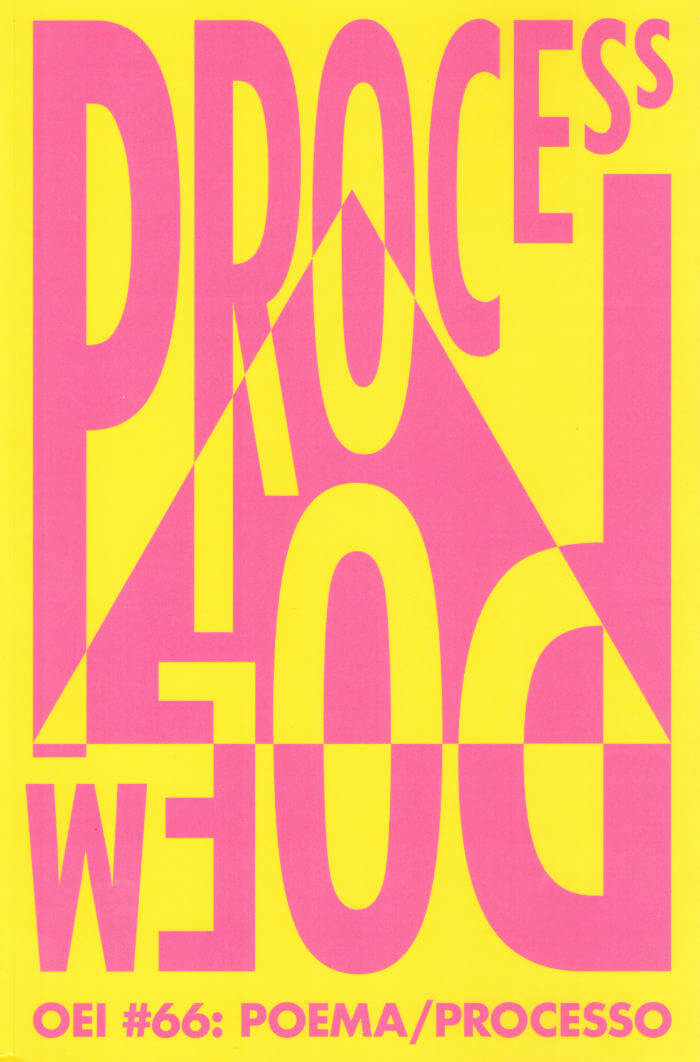
OEI #66 Poema/Processo (Process/Poem)
Jonas J. Magnusson, Cecilia Grönberg and 1 more
“We were not claiming European influences, as concrete poetry did. Europe would not accept a visual culture born in Brazil, so this claiming was necessary for concrete poetry, but not for poema/processo as it had pan-Latin-American connections” (Wlademir Dias-Pino)
Already a classic, this issue of OEI presents the Brazilian avant-garde movement Poema/Processo through a huge selection of images, poems, and short essays, showing the different strategies this movement used between 1967 an 1972 in order to survive and develop under the pressure of the militarian regime. Are also featured three other less-known Brazilian movements from the 60s, 70s and early 80s: poesia práxis, poesia marginal, pornismo.
With Wlademir Dias-Pino, Wlademir Dias-Pino, Moacy Cirne, Álvaro de Sá, Fernanda Nogueira, Priscilla Guimarães Martins, João Felício dos Santos, Rogerio Camara, Neide de Sá, Eduardo Kac, Antonio Sergio Bessa, Décio Pignatari, Luis Ângelo Pinto, Décio Pignatari, Dailor Varela, Falves Silva, Jota Medeiros, Cristina Freire, Dácio Galvão, Clemente Padín, Almandrade, Mário Chamie, Sergio Cohn, Omar Khouri, Régis Bonvicino, Regina Silveira, Hudinilson Jr.
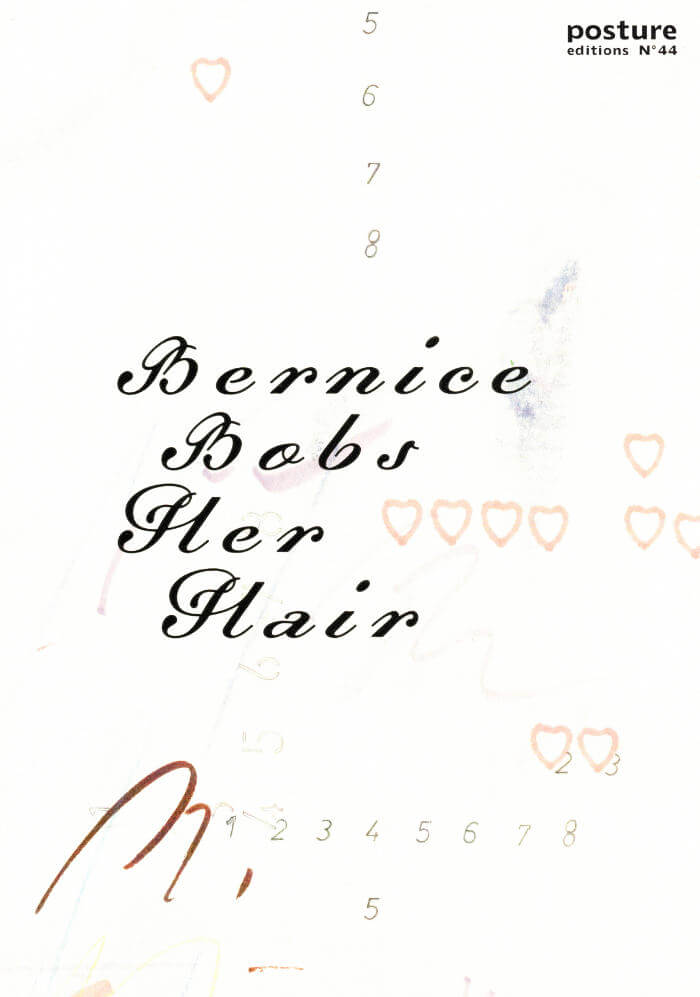
Bernice Bobs Her Hair
‘Bernice Bobs Her Hair’ is a series of layered soft ground etchings, drawings and monotypes. The title is a nod towards a Fitzgerald story about Bernice, who changes her approach to traditional gender roles and youth over a visit to her niece Marjorie. The act of having her hair cut transforms her character into a real flapper and brings her to a new perception of femininity.
Starting from the biased idea and normative use of marginalised graphic procedures as a means of reproduction, the idea of repetition is explored so that iterations become alterations or modifications of the same.
Simultaneously, associations cease to exist and the pregnant B, punning at times, as form and counterform encloses the work.
Fluid figures, painterly gestures and cartoonish scrawls and patterns are subject to a reflection on cuteness, power (-lessness), sexuality and domesticity.
By highlighting marginalised modes of artistic practice and craft-informed techniques, Mabesoone recoups visual languages that have habitually been coded as ultra-feminine and trivial. She questions how these ambiguous and subversive aesthetics can gain authority, and destabilise or resist contemporary realities and dominant cultural constructions.
The book contains poems by Veva Leye and a republication of ‘Trimmings’ by Harryette Mullen.

Rainbow Woman
In her work, Dutch artist Femmy Otten (°1981) explores a very hybrid world of inspiration, ranging from sculptures from Greek antiquity and Italian painters of the quattrocento to American outsider art and contemporary art. She brings all these influences together in a precise yet unfathomable iconography.
The book Rainbow Woman shows mainly recent work, but also revisits a number of older works which Otten has regularly placed in a new context throughout her artistic practice and which have now also been given a new shape in the context of the exhibition in the Warande, Turnhout (01.08-07.11.2021).
Rainbow Woman shows Otten as a versatile painter, sculptor, draughtsman and performer. In ‘Donna Universale’, the art historian Leen Huet places Otten in a tradition of self-confident, female artists that Europe has known since the early Renaissance but who have only sporadically entered the history books as artistically accomplished artists.
The book has many points of contact with the exhibition Rainbow Woman but can also be seen as a sequel to the artist’s book Slow Down Love (2016, nai).

Horaizon
Meggy Rustamova’s (b. 1985) practice explores films and spatial installations, in which she incorporates photographs, essays and audio material; often the work has a performative character. Concerned with the relations between individual and collective memory, language and human behaviour, her works look for ways to translate the current matters and phenomena in the world.
The title of the book and the exhibition, HORAIZON, refers to the phonetic pronunciation of the English word ‘horizon’, the boundary line on which the earth’s surface and the sky seem to touch. The horizon, interpreted as ‘boundary’ or ‘line’, is equally perceptible in language, when reading between the lines, or when travelling between international borders. The contours of the land, trees or buildings, which contrast with the sky, but also the contours of shadows can be observed in many of the images in the exhibition. The works also suggest a longing for what lies behind the horizon and invite the viewer to make an imaginary journey.
On the occasion of Rustamova’s exhibition at the Vrienden v/h S.M.A.K. and the book ‘Horaizon’, the artist created a multiple. The multiple is entitled 1000 km in Vogelvlucht — 621.371 miles at Bird’s Eye View and unfolds as a storyboard, with a collection of sky views and birds the artist has captured over the past two years. From a condor in Arizona to the black-backed gulls in Iceland in the North Atlantic Ocean all through the Sea of Marmara, the book seeks to create a tale that reflects on a person’s daily need for freedom, travel and nature.

Morning Change
Morning Change is a book on movement, location and nomadism in the oeuvre of the Brussels based German artist Heide Hinrichs (b. 1976). It is an invitation to follow different lines that are directed east — east of Kassel, east of Busan, east of Seattle, east of London. The lines are drawn over continents and oceans, against the Earth’s own movement we unconsciously witness with each sunrise. Within the traces of these lines, static objects are put back into motion and they are made to leave their recommended positions of meaning.
The publication brings together three groups of works, developed over different periods of time between 1999 and 2018, exploring the artist’s recurring interest in these topics.
the horse — a story that starts 10 year after the fall of the Iron Curtain, Silent Sisters / Stille Schwestern together with a series of drawings and installations that were conceived in response to DICTEE — a text written by the Korean-American artist Theresa Hak Kyung Cha and On Some of the Birds of Nepal (Parting the Animal Kingdom of the East) — an installation that Hinrichs created in the context of the first Kathmandu Triennale 2017.
An essay by Elizabeth Haines is woven through Morning Change.

Hundred Zundert
Nel Aerts (b. 1987) moves in a freely, intuitive way between different media as painting, drawing, collage, performance and sculpture. Since a few years she focuses more often on the portrait-genre, which she visualises on paper or on wooden panels, with careful attention to the different qualities of each material. As such, she is creating a large collection (family almost) of posing subjects caught between abstract patterns and hard-edged figuration. The figures she portraits refer to both popular culture and her direct, everyday surroundings.
The self-portraits are tragicomic in the sense of the contrasts they evoke. Alternately they are desperate or funny, extra- or introverted, thought- or playful carved from wood or originated as a collage, but they are always introspective and self-relativistic.
In Hundred Zundert, “Nel Aerts evokes a visual rendezvous with Vincent van Gogh and sets the tone for the near one hundred drawings that would be made during her three-month residency at the Van Gogh House in Zundert. Rather than ‘following in the footsteps of Van Gogh’, Aerts is interested in examining the mud and earth around them by (literally) placing herself in the environment of Van Gogh’s youth. The resulting work is characterised by a deceptive interplay between formal simplicity and playfulness which belies a substantial complexity. (…) Nel Aerts’s working process is uncomplicated and free of any pretension: black ball pen (dozens), sheets of white A4 paper (hundreds) and spontaneous, almost naive line work (in seemingly infinite supply) are the building blocks of a story that is nevertheless rich in visual and intimate detail, a story that teeters between seriousness and playfulness, at once both comical and deeply emotive.” From: ‘Portrait of the Artist’, Grete Simkuté, in: Hundred Zundert.